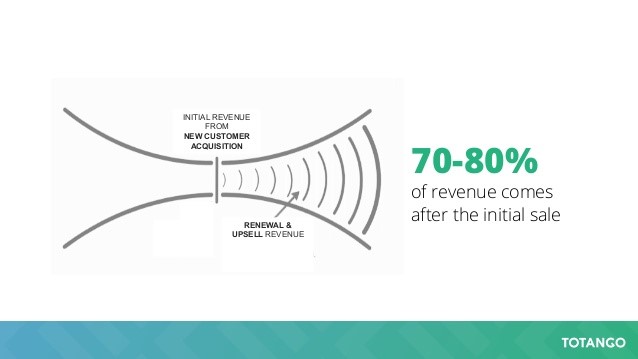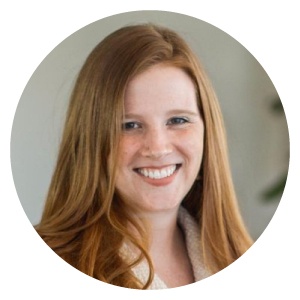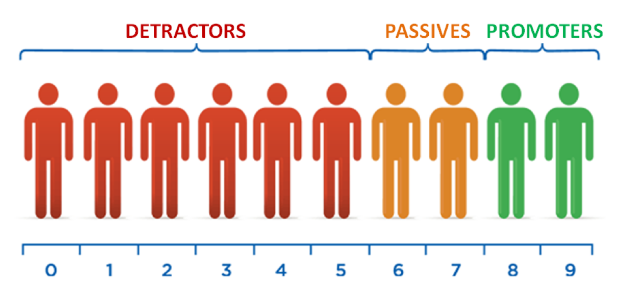The success of every SaaS business is directly tied to its ability to retain customers and create recurring revenue.
It’s no longer enough for SaaS businesses to simply acquire as many users as possible, because customer acquisition is just the tip of the iceberg. Instead, SaaS businesses are competing to see who can:
- Turn the most free trial and ad-hoc users into committed, paying customers;
- Create the most active and engaged customers;
- Earn the most (successful) customer referrals;
- And retain the greatest percentage of their customers.
As SaaS businesses strive to set themselves apart from their competitors, customer success is increasingly becoming the differentiator between ‘success’ and ‘failure’ in the competitive SaaS space.
But does your SaaS business need to invest in Customer Success rather than spending that money on Marketing and Sales activities, which would attract more leads and increase customer acquisition?
The short answer is: yes. Investing in Customer Success can help you unlock huge opportunities for revenue growth.
In this post, I’m taking a closer look at the why, what and how of Customer Success, to help you improve customer retention, reduce churn and increase customer lifetime value, and even drive viral growth through referrals.
Why Customer Success Matters in SaaS
Caleb Elston, Delighted
Customer Success is critical in helping customers get more value from your product
To grow in a predictable, sustainable way, it’s becoming increasingly vital for SaaS businesses to invest in Customer Success, and build-in measurable Customer Success processes and practices, as early as possible.
In the first part of this post, I’m laying out the case for investing in Customer Success to drive growth for your SaaS business, before we dive in to what exactly Customer Success is, how you can get started with Customer Success in your company, and key metrics to measure to keep you on-track in parts 2, 3 and 4.
How Churn Can Stifle Your Revenue Growth
Almost all SaaS companies are subscription-based business. This means that the growth of your SaaS business depends not only on maximising the acquisition of new customers, but also minimising the loss of existing customers.
A small improvement to churn rate can have a huge impact on your overall revenue. The chart below highlights what a huge difference a churn rate of just 8 percentage points can make to your MRR (monthly recurring revenue):
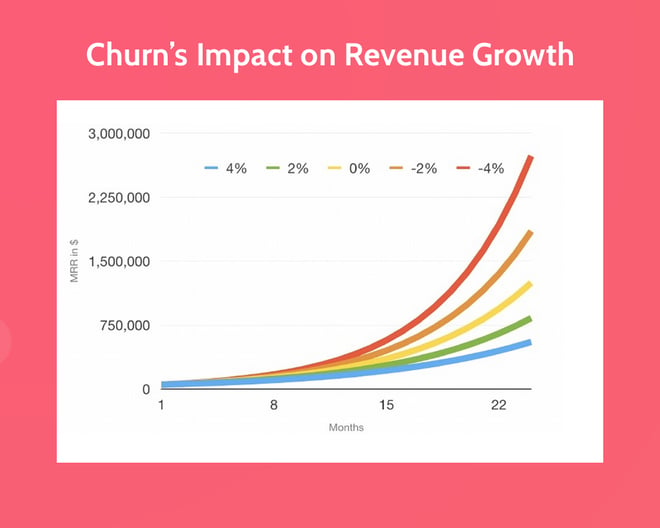
Furthermore, revenue churn grows exponentially as your ARR (Annual Recurring Revenue) grows. This example from David Skok demonstrates how a reasonable-sounding 2.5% monthly revenue churn rate (amounting to a more worrying 30% annual churn) becomes a bigger and bigger concern, as your ARR increases:
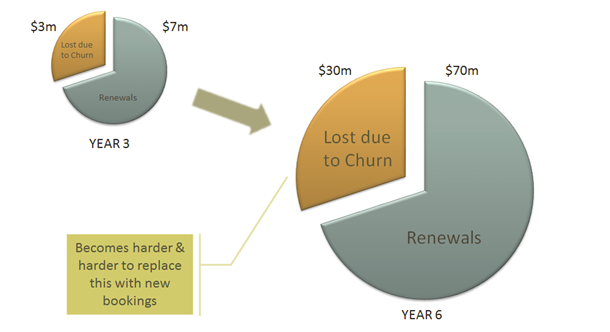
In the first chart, the business loses $3m in revenue over the course of a year due to churn, but in the second chart this has increased to $30m. Even if it was relatively simple for you to acquire enough new customers to make up for $3m lost to churn, acquiring $30m worth of new customers, just to maintain the same level of revenue as the previous year, will be much more difficult.
As your SaaS business grows, and your ARR increases, the cost of replacing revenue lost through churn becomes more and more difficult. The higher your customer churn rate, and the higher your revenue churn, the more difficult it will be for your SaaS business to achieve revenue growth through new customer acquisition alone. That’s where customer success comes in.
How Customer Success Contributes to Revenue Growth
Lincoln Murphy, Sixteen Ventures
The majority of the revenue from your relationship with a customer happens post-sale. The emphasis is on both keeping the customer longer and also expanding the relationship
Recurring revenue is the lifeblood of your SaaS business. Traditionally the majority of startup investment goes into Marketing and Sales activities, to attract and acquire customers in the first place. But this isn’t where the biggest proportion of your revenue comes from. Totango estimate that most of your revenue – as much as 70-80% - comes after the initial sale:
Upsells and Cross-sells
Jason Lemkin, SaaStr
The best SaaS companies can grow almost 40%, 50%, 60% a month year over year, just upselling to the existing base without even new customers
Renewals, upselling and cross-selling all significantly increase revenue generated by each customer, after the initial sale.
For example, a customer spends $1,000 for a year’s subscription to your SaaS product.
If they renew that after the first year, that adds another $1,000 to their CLV, but what if after their first year they want to upgrade to your next level package, with added functionality for an extra $500 (upselling), and in their third year, on top of their increased spend, they want an add-on service for an extra $250 (cross-selling)?
$$\text{CLV }=$1,000+($1,000+$500)+($1,000+$500+$250)=$4,250$$
What started as a $1,000 sale has totaled $4,250 after three years, with the initial sale counting for just 23.5% of that 3-year total.
With a great product, and investment in customer success to prioritise customer retention as well as acquisition, it should be possible to successfully upsell and cross-sell to a portion of your customers, and generate significant amounts of additional revenue by growing your existing customer accounts.
Up-sells, cross-sells, referrals and advocacy can generate huge amounts of revenue.
3 Reasons You're Underestimating Your SaaS CLV
Second Order Revenue
Additionally, second order revenue coming from customer referrals or what Jason Lemkin refers to as “champion change” (where a customer of your SaaS product changes company and introduces it to their new company, ‘championing’ its adoption for a second time) are a significant source of revenue that is often overlooked in traditional CLV calculations.
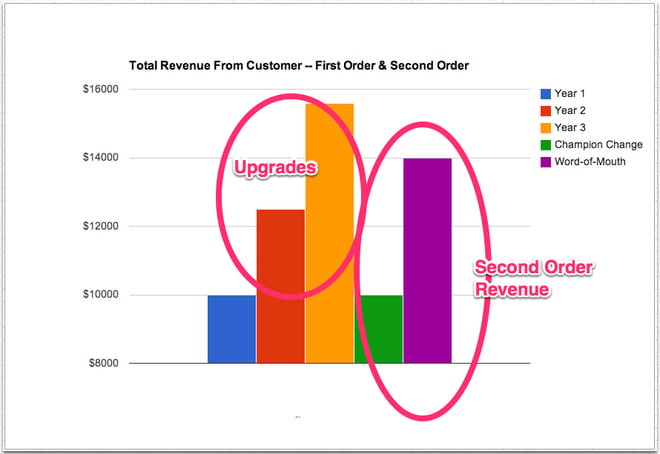
Customer referrals (and to a lesser extent, champion change) can be a powerful growth engine, and one that’s driven entirely by customer success. Only happy, successful customers will recommend your product to other people, or keep using it voluntarily, when they move to a new company.
By overlooking second order revenue from referrals and advocacy, SaaS businesses completely underestimate the importance of investing into customer success.
3 Reasons You're Underestimating Your SaaS CLV
It’s clear that customer referrals and champion change are important channels of growth and sources of additional revenue, capable of increasing your user base and monthly revenue without any additional sales and marketing investment.
But for upsells, cross-sells, referrals and advocacy to be successful, you first of all need to retain customers, and to do that you need to invest in customer success: to understand your users’ goals and desired outcomes from using your product, and make sure that your product helps them meet those goals.
What is Customer Success?
Before your company starts to invest in Customer Success, it’s vital that you understand what it is – and equally, what it is not.
Aaron Ross
Customer Success is a growth driver. It is not glorified support.
Customer Success is not just another name for your sales team, or your customer support team. Rather, Customer Success is a defined strategy based around understanding your customers’ goals, and enabling them to achieve them.
You need to know what your customers want to achieve as a result of working with you – the problem they are trying to solve – so that you can ensure your SaaS product provides a solution to their problem and enables them to meet their goals. As long as they’re achieving their goals, and getting value from your product, your customers are likely to keep on using it.
Lincoln Murphy, Sixteen Ventures
Customer Success is when your customers achieve their Desired Outcome through their interactions with your company.
Customer Success flips your focus away from your business needs, and makes your customers’ needs your top priority. As a result, your focus shifts away from activities geared toward customer acquisition, and towards customer retention: making sure that your customers are getting real, measurable value from your service, and that they are getting enough benefit from using it to justify paying the recurring cost for your SaaS solution – each and every month.
The 4 Stages of Customer Success
Depending on where they are in their lifecycle, your customers will need different things from your SaaS product to help them achieve their Desired Outcomes.
Once a customer signs up for your SaaS solution, there are four main lifecycle stages they move through. Breaking down ‘Customer Success’ into four distinct sections will enable you to identify any sticking points or areas of potential weakness for your business, so you can make targeted improvements where it’s needed most.
Activation
According to Intercom, 40-60% of new users will use your product once, and never return. This is why the activation stage is so important.
In the activation stage of the customer lifecycle, your customers are just getting started using your SaaS solution. This is when they work through your onboarding tasks or tutorial, and when they (hopefully) start to generate value from using your solution.
George Szundi, Natero
A successful onboarding paves the way to retention, renewal and even up-sell in the future.
The secret to successful activation is to generate value early. From the very first session, your new customer is asking:
"Does this product solve the problem I am experiencing? Is this product better than other, similar products at solving this problem for me?"
If your users get real value from your SaaS product in their first few sessions, there’s a great chance they’ll come back for more. But if they can’t, it’s likely they’ll stop using your product, and go looking for an alternative.
Expansion
By the time your customers reach the Expansion stage, they will be regular, active users of your SaaS product. This means that you have successfully onboarded them, guided them through the initial set-up, and that your SaaS product is providing enough ongoing value to keep them coming back for more – and keep paying for it every month.
With customers successfully using your product, this is the point where you can identify potential customers who might be suitable for upselling or cross-selling opportunities. There may be usage data in their account that suggests they’ll benefit from additional features available from higher-price packages, or from additional functionality available from complementary, add-on packages. Alternatively, the customer themselves may identify this need, wanting additional user accounts or greater functionality.
The Expansion stage is all about identifying customers who are a good-fit prospect for upselling or cross-selling, and encouraging the additional sale if it makes sense for their unique use case.
Remember: the focus is on your customer’s needs, not your business needs.
Emily Triplett Lentz, Help Scout
Doing right by our customers is priority numero uno, so we don’t attempt to upsell unless it makes sense for our customer’s business.
Renewal
Customer renewal is a vital driver for every recurring revenue business.
Totango
If you’ve been keeping an eye on your customers’ usage data, by the time they reach Renewal you should have a pretty good idea of whether they’re likely to renew their contract with you, or not, by identifying your ‘red flag’ metrics.
For example, SaaS startup Groove analysed their users’ session data and found that length of session and frequency of log-in were their most significant ‘red flags’ that a user was at-risk of churning.
After the Activation stage, the Renewal stage is the next point when your customers are most at-risk of churning. When your customers’ initial contracted use period comes to an end, they have to make a choice: to continue paying for, and using, your SaaS solution; or to switch to an alternative service with different functionality.
Referral
Customer referrals are key to growing your SaaS business, and unlocking the potential for driving viral growth. Referrals are the holy grail of SaaS, growing your user base (and revenue) without the need for added investment from Sales and Marketing. And referrals are driven almost entirely by customer success: only happy, successful customers will want to recommend your SaaS product to their personal network.
Referrals are the ‘final’ stage of Customer Success – the stage where your customers transition from being committed users of your service, to being advocates of your service who are so impressed with the value you deliver, that they’re recommending your service to colleagues, friends or other people in their network.
Learn how to build a successful SaaS customer referral program, in six simple, actionable steps.
How to Get Started with Customer Success
Alex Turnbull, Groove
Almost every successful software company that I can think of has gotten to where they are – or at least to initial traction – on the success of their customers.
In the early days, the initial priority for almost all SaaS companies is customer acquisition. You aim to attract as many paying customers as you can, as quickly as possible, to fuel your rapid growth. But the bigger you get, the harder it becomes to maintain the same rapid growth rates through customer acquisition alone. Therefore, it becomes necessary for your focus to shift, away from acquisition and onto customer retention, upselling, cross-selling and referrals.
When you start to gain traction, it’s essential for your priority to shift… it’s time to focus on Customer Success: fuelling growth through the retention and upselling of your existing customers.
The Ultimate SaaS Metrics Guide to Smarter, Faster Growth
Customer Success should be an ongoing commitment for growing SaaS companies, but when you first want to start investing your time and energy into Customer Success, it can be difficult to know where to start.
Here are 5 simple, actionable ways you can get started with Customer Success, and help your SaaS company unlock another opportunity for growth.
1) Change Your Mindset
The first step to getting started with Customer Success is to change your mindset.
You need to stop focusing all of your energy on acquiring as many customers as possible, and start focusing on the customers themselves. After all, without your customers, where would your company be now?
A customer-focused mindset means that every decision you make will be guided by the needs of your customers. You need to be able to answer:
- What problem is your customer trying to solve when they purchase your SaaS product?
- How well does your product solve that problem?
- Will [new feature] provide added value for your customer? Is it something they actually need, or is it just dealing with a symptom, rather than the cause of a problem they’ve identified with your SaaS product?
- How will your product add value for your customer today – how will it add further, ongoing value in the future?
Simply put, customer success starts with your culture. You need to re-frame your business to put your customers at the heart of everything you do, and every decision you make, no matter how big or small.
2) Identify the Sticking Points
Where are the sticking points in your customer relationships?
Do you have a ton of visitors coming through to a landing page, but none signing up for a free trial? This indicates a mismatch between your marketing activity and your service offering: you’re attracting potential customers who are a poor fit for your SaaS product, so you need to revisit your marketing messaging.
Alternatively, you might have a large number of sign-ups for your free trial, but very few users making it past their first couple of sessions. This indicates a problem with your onboarding process: maybe it’s too complex; maybe it’s not delivering real value, fast enough; or maybe it’s a marketing problem again - users sign up, log in, and then realise your SaaS product doesn’t do what they expected it to do.
Or do you have a huge drop-off in users, who cancel their subscription after their initial contract period? This suggests that while your product was good at providing early value, through onboarding and the duration of their trial, it’s not so good at providing ongoing value to your customers.
These are some of the more common sticking points for SaaS companies. By identifying where you see unusually high drop-off rates, you will get a clear indication of where your users are encountering problems. You can then focus your energy on fixing those sticking points, to help improve customer retention.
3) Talk to Your Customers
Chargify
Talk with each of your first 100 customers and truly understand what “value” is to them… Once you define value with your customer, establish goals that lead to achieving that value.
It doesn’t matter how great your product is in theory: if it doesn’t provide real value for your real customers, you’ve got a problem.
Customer Success is all about ensuring your SaaS product enables your customers to reach their desired outcomes, and what better way to make sure you’re on the right track than to actually talk to your customers?
Additionally, once you’ve identified the sticking points in your customers’ lifecycle, you can reach out to them at key moments. For example, a timely email with some helpful pointers could make the difference between your customer completing your onboarding process, or ditching it half-way through.
Great communication is key to Customer Success. You need to know what your customers need from your product, rather than making assumptions – so as well as reaching out to talk to your customers, you need to listen to what they say, and the feedback they provide.
4) Start Small
When you first start focusing on Customer Success, it doesn’t mean making massive, sweeping changes to the way your company operates.
Once you’ve re-framed your focus so that your customers are at the heart of everything you do - driving every development decision, directing your marketing activities, shaping the way your sales team works - you can start implementing customer success in small ways.
Even something as small as a ‘thank you’ is a great way to start: it lets your customers know that you value them on an individual level.
5) Measure and Improve
You can’t improve what you can’t measure, and you also can’t track your progress if you don’t know where you started.
If you want a benchmark for your Customer Success performance, the best thing to do would be to measure a few key metrics before you start your Customer Success activities, so you can measure the impact it’s having on customer retention, onboarding, and renewals.
Measuring a handful of key Customer Success metrics will help you understand your customers’ behaviour: how and why they’re engaging with your SaaS product and your business.
You can't measure and improve Customer Success performance without the right software, which is why we recommend HubSpot. We've worked with HubSpot for over a decade, and their software is unmatched for SaaS companies which want both a holistic view of their Customer Success performance and the tools necessary to intervene when upsells are possible (or churn seems likely).
10 Customer Success Metrics
In the final part of this post, I’m sharing the top 10 customer success metrics you need to measure, to track the efficacy (and ROI) of your customer success efforts.
However, you also need to understand what success looks like for your customers, so you know whether or not you’re on-track. Understanding your customers’ success factors will provide you with valuable insights into your customer priorities, and provides the context to help you interpret your Customer Success metrics.
1) Churn
Churn is the single most important metric for assessing the health and growth of your SaaS business, after MRR. However, one of the most common mistakes we see is SaaS companies incorrectly calculating churn rate, which leads to distorted customer and revenue growth statistics.
There are two different types of churn:
Customer churn measures the rate at which your existing customers cancel their subscription to your service.
$$%\text{ Customer Churn Rate}=\frac{\text{Customers that churned in period t}}{\text{Total customers at the start of period t}}$$
Revenue churn (also referred to as ‘MRR churn rate’) calculates the rate at which monthly recurring revenue (MRR) is lost, as a result of customer churn and downgraded subscriptions.
$$\text{% MRR Churn Rate}=\frac{\text{Churned MRR}}{\text{Previous MRR}}$$
Customer churn tells you how good you are at retaining customers, while revenue churn tells you how good you are at retaining customer revenue.
While these two concepts seem similar, they aren’t the same. Learn more about the difference between customer and revenue churn, and how both metrics can help you grow your revenue and customer base.
2) Onboarding Engagement
Onboarding and initial activation is one of the points when your customers are most at-risk of churning: they’ve signed up for your service, but you haven’t proven that you can actually solve their problem yet.
Your onboarding process needs to provide real value to your new users, and quickly.
Measuring engagement with your onboarding process will help you improve it, but also help you identify at-risk users, who are struggling to make use of your product, and so are likely to churn.
To measure onboarding engagement, you need to track:
- The percentage of customers that start your onboarding process
- The percentage that complete the process
- The average time taken to complete onboarding
- The percentage rate of progress through each step in your onboarding process.
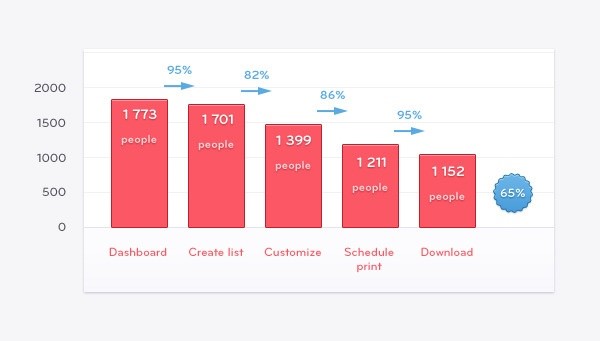
3 & 4) Upsell Rate and Cross-Sell Rate
Upselling and cross-selling are a vital source of expansion revenue, and are a valuable driver of growth for your SaaS business.
The same calculation is used for both, and allows you to work out what percentage of a period’s revenue was generated from upselling (encouraging existing customers to increase their spend) or cross-selling (encouraging existing customers to purchase complementary services in addition to their existing spend).
$$\text{Upsell Rate} = \frac{\text{Annual Contract Value of Upsells}_t}{\text{Total Annual Contract Value}_t}$$
5) Net Promoter Score (NPS)
Caitlin Daily, Promoter.io
The best way to reduce or even eliminate customer churn is by continually measuring customer loyalty with NPS
The Net Promoter Score is a tool that’s used to try and quantify customer satisfaction with your SaaS product. It allows you to keep a finger on the pulse of how your customers are feeling about the quality of your service and the value delivered by your SaaS product. It asks your users a super-simple question:
“How likely are you to recommend [SaaS product] to a friend or colleague?”
Your users respond on a scale from 0 (not at all likely) to 10 (extremely likely):
From there, you can calculate your Net Promoter Score by subtracting the percentage of detractors from the percentage of promoters:
$$\text{NPS} = %\text{Promoters} - %\text{Detractors}$$
6) Viral Coefficient
If Net Promoter Score helps reveal the intention of your customers, the viral coefficient helps to measure their action. It tells you how many new users a current user is referring to your business.
To work out your viral coefficient, you can use the method below:
- Take your current number of users
- Multiply by the average number of referrals each user makes
- Multiply by the conversion rate of those referrals (% of referrals that result in a new user)
- Divide by your current number of users
$$\frac{\text{Number of Users}\times\text{Average Number of Referrals}\times\text{Referral Conversion Rate}}{\text{Number of Users}}$$
A viral coefficient of 1 or above means that for every user you acquire, you'll gain one (or more) additional user(s) through the referral process.
Many people argue that a viral coefficient of less than 1 is worthless, but this is only the case if user referrals are your only source of growth. Assuming you acquire customers in other ways, then even a low viral coefficient will contribute to your growth.
7 & 8) Daily & Monthly Active Users
This is a simple measurement of the number of active users in a given time period. It’s common for SaaS companies to look at their Daily Active Users (DAU), and also their Monthly Active Users (MAU).
The key to getting helpful insights from measuring DAU or MAU is to clearly define what you mean by ‘active’. For example, many SaaS companies use DAU to count the number of users who logged in on that day, but ‘logging in’ doesn’t necessarily equate to ‘active’.
Lincoln Murphy, Sixteen Ventures
When it comes to “activity” in your app, you need to know what activity patterns equate to value delivered.
Simply logging in is no guarantee that your user is getting any value from your SaaS product; in fact, they might not be using it at all, and could instead be logging in to close their account or submit a support request.
9) Referral Revenue
Referrals are a hugely important driver of growth for your SaaS business, and it’s vital that you keep track of how much revenue you’re generating via referral channels.
Referral revenue is a simple aggregate measurement of all the revenue generated by successful customer referrals over a particular time period. Calculating referral revenue is a simple way to identify trends in successful referrals over time, and while it’s worthwhile to calculate this, it doesn’t offer any in-depth insights.
10) Referral Return on Investment
While it’s good to keep a handle on how much revenue you’re generating via referral channels, calculating your referral revenue doesn’t provide any deeper insight than that.
So if you want to go a step further, calculating Referral Return on Investment (ROI) will allow you to compare the amount we’re investing in customer referrals with the amount of revenue those referrals will generate over their lifetime.
If your average customer pays $100/month over a lifetime of 2 years, their LTV is $2400:
$$\text{LTV}=$100\times24\text{ months}=$2,400
For your referral scheme, you’re offering 10% off the monthly bill for 12 months for the referrer, and one-month free for the successful referral.
$$\text{Cost of Referral Incentive} = $100+(($100\times0.1)\times12)=$220$$
Calculating the Referral ROI will show how many dollars in LTV we’re generating for each dollar you spend on referral marketing and incentives:
$$\text{Referral ROI}=\frac{\text{LTV}-\text{Referral Incentive}}{\text{Referral Incentive}}$$
$$\text{Referral ROI}=\frac{$2,400-$220}{$220}=$9.90
This means that, in this case, we’re generating $9.90 in LTV for every $1 we’re spending on the referral.
First Steps
Customer Success can’t be thought of as a one-stop, quick fix for your SaaS product. It requires a complete shift in mindset, and should be an ongoing investment, to help you provide continuing value to your customers.
A customer-first mindset is the most essential component of your Customer Success strategy: solve for your existing customers’ needs first, in order to reduce churn and improve customer retention. Then, as your SaaS company grows, you can expand the breadth of your Customer Success activities to also focus on upselling and cross-selling, and then securing more customer referrals.
There are lots of different ways for your SaaS company to get started with Customer Success, so start with small, actionable steps; measure your activities so you can make data-driven improvements as you go; and scale your Customer Success activities as your SaaS company grows.
Want to take one of those small, actionable steps today?
Click here to get your free HubSpot Customer Service Tools account.
In our experience, their Customer Success Software is unmatched.




